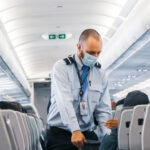American Airlines, a renowned airline company, has recently commenced its latest route to connect state capitals with seamless and swift nonstop flights. The newest addition to their impressive list of routes is between Sacramento and Austin – two prominent cities in the United States. The nonstop flight service was inaugurated in early May 2023 amid much anticipation and excitement from avid travelers who have been eagerly waiting for American Airlines’ first-flight services from Sacramento to Austin since the onset of the pandemic almost two years ago. This move marks another milestone for American Airlines as they strive to enhance connectivity among different states while ensuring maximum comfort and convenience for their passengers during these unprecedented times.
However, the pandemic has dealt a heavy blow to the airline industry as travel restrictions and reduced demand have significantly impacted their revenue. American Airlines, like most airlines, has had to navigate these challenging times by implementing cost-cutting measures such as reducing staff and trimming its fleet size. Moreover, the pandemic has created volatility in the airline industry resulting from investor sentiment in response to COVID-19 pandemic news.

In addition, the pandemic’s disruption in the airline sector has significantly impacted several other dependent industries, such as aircraft manufacturing, hotel, tourism, and airline catering businesses. Various studies have been conducted to examine the impact of the pandemic on the airline industry, including identifying structural aspects of risk management that may be employed by airlines, evaluating the effect of different boarding methods adapted for the pandemic, and analyzing social and emotional perspectives of airline passengers like their willingness to travel during the pandemic. One of the most significant impacts of the pandemic on airlines is the reduced demand for air travel resulting from travel restrictions and health concerns. Despite the challenges brought on by the pandemic, American Airlines continues to navigate these uncertain times and provide essential air travel services. American Airlines’ recent launch of nonstop flight services between Sacramento and Austin is welcome news for the airline industry — a beacon of light as we all recover post-pandemic.
Post-Pandemic Measures to Thwart Future Disruptions
The pandemic has highlighted the need for airlines to implement post-pandemic measures to prevent or reduce future disruptions.
One such measure is to increase flexibility in the airline industry supply chain to better respond to uncertain situations. Operators can achieve flexibility by creating agile business models that enable airlines to adapt and respond to changing market conditions quickly. Additionally, airlines should continue to prioritize safety and health measures to alleviate passengers’ concerns about traveling during a pandemic. Moreover, airlines should explore innovative technologies such as biometric scans and contactless payment to minimize physical contact between passengers and airline staff. Furthermore, government support and collaboration with the airline industry are essential in ensuring a safe and sustainable recovery. Another aspect that needs to be studied is how the airline industry and other dependent industries, such as airline catering businesses, can manage their performance measures and supply chains to cope with disruptions caused by a global pandemic. Here are the key takeaways from the pandemic for the airline industry:
- Financial support and cost reduction: Seek government assistance, loans, and grants to stabilize the economy. Implement cost reduction measures such as layoffs, wage cuts, and reductions in non-essential spending.
- Diversify revenue streams: Explore new revenue streams beyond traditional ticket sales, such as cargo services, ancillary products, and partnerships with other businesses.
- Reevaluate route network: Adjust route networks based on demand patterns and profitability, focusing on high-demand and profitable routes while temporarily suspending low-demand routes.
- Enhance digital customer experience: Invest in digital tools and platforms to improve customer experience, enable contactless services, and streamline the booking and boarding process.
- Health and safety measures: Adopt stringent health and safety protocols, such as deep cleaning of aircraft, mandatory face masks, and health screenings to reassure passengers and increase confidence in air travel. Also, ensuring airports have wheelchair ramps and other accessibility features are crucial for travelers with disabilities.
- Flexible booking policies: Provide passengers with flexible booking options, allowing changes and cancellations without penalties, accommodating uncertainty, and encouraging future bookings.
- Strategic partnerships and alliances: Forge alliances and partnerships with other airlines, hotels, and travel agencies to offer bundled packages, share resources, and reduce costs.
- Focus on sustainability: Invest in fuel-efficient aircraft, implement sustainable practices, and engage in carbon offset programs to address growing concerns about the environmental impact of aviation.
- Adjust fleet size and composition: Retire older, less fuel-efficient aircraft and focus on a more efficient fleet to reduce operating costs and increase flexibility in operations.
- Data-driven decision-making: Utilize data analytics to track industry trends, predict demand, and optimize pricing and capacity to maximize revenue.
Onwards to Diversifying Revenue Streams
 Airlines can diversify their revenue streams and venture into new territories beyond the traditional sales of tickets. Diversifying allows airlines to explore fresh opportunities and ensures a more robust and varied earnings range. By engaging in various means, such as additional ancillary services or collaborations with different industries, airlines can expand their reach towards potential customers from diverse backgrounds, ultimately leading to sustainable growth for themselves and their partners. In today’s competitive aviation industry landscape, pursuing alternative methods is necessary for any airline that aims to stay ahead of the curve by creating unique offerings that cater to customer needs while still generating ample profits through innovative approaches. Here are a few ideas on how airlines can maximize their revenue opportunities:
Airlines can diversify their revenue streams and venture into new territories beyond the traditional sales of tickets. Diversifying allows airlines to explore fresh opportunities and ensures a more robust and varied earnings range. By engaging in various means, such as additional ancillary services or collaborations with different industries, airlines can expand their reach towards potential customers from diverse backgrounds, ultimately leading to sustainable growth for themselves and their partners. In today’s competitive aviation industry landscape, pursuing alternative methods is necessary for any airline that aims to stay ahead of the curve by creating unique offerings that cater to customer needs while still generating ample profits through innovative approaches. Here are a few ideas on how airlines can maximize their revenue opportunities:
- Cargo services: With the growth of e-commerce and the need for faster delivery times, airlines can capitalize on the cargo market by providing air freight services or partnering with logistics companies.
- Ancillary products and services: Airlines can increase revenue by offering additional services such as in-flight Wi-Fi, premium seat selection, baggage services, priority boarding, and travel insurance.
- Loyalty programs and co-branded credit cards: Airlines can enhance their loyalty programs and offer co-branded credit cards to encourage frequent flying and boost customer spending.
- Subscriptions and memberships: Introduce subscription-based models or membership clubs that offer benefits like unlimited flights within a specific time frame, lounge access, or priority services for a fixed fee.
- Advertising and sponsorship: Airlines can generate revenue from in-flight advertising, sponsored content, or brand partnerships for product placement and promotions.
- Maintenance, repair, and overhaul (MRO) services: Airlines with their own maintenance facilities can offer MRO services to other airlines, generating additional revenue.
- Charter flights and private jet services: Offer charter flight services for businesses, sports teams, or VIP clients, as well as private jet services for affluent customers.
- Travel packages and partnerships: Partner with hotels, car rental agencies, and tour operators to offer bundled travel packages, providing a one-stop shop for customers and generating additional revenue.
- In-flight retail: Expand in-flight retail options, including duty-free items, exclusive merchandise, and food and beverage offerings, to increase onboard spending.
- Training and consultancy services: Airlines can leverage their expertise in various areas, such as pilot training, safety management, and operational efficiency, to provide training and consultancy services to other airlines or related industries.
By diversifying their revenue streams, airlines can reduce their dependence on ticket sales and become more resilient to fluctuations in the travel market.
With the COVID-19 pandemic causing a severe disruption in the airline industry and several other dependent sectors such as aircraft manufacturing and hotel and tourism businesses, implementing these strategies and adapting to the changing environment will be critical in ensuring airlines’ sustainability. Airlines must be flexible and innovative in adjusting their revenue streams, route networks, customer experience, health, and safety measures, booking policies, partnerships, sustainability efforts, fleet size, composition, and decision-making strategies. By implementing these strategies, airlines can better prepare themselves for future pandemics or other unforeseen events and strengthen their long-term resiliency.
As the airline industry emerges from the stormy skies of the pandemic, American Airlines’ new nonstop route between Sacramento and Austin symbolizes a beacon of hope in a landscape marked by unprecedented challenges. Like intrepid pilots navigating through turbulent weather, airlines must chart a new course to recovery by embracing adaptability, innovation, and resilience.
The key to soaring above the uncertainty lies in diversifying revenue streams and venturing beyond the traditional horizon of ticket sales. By exploring uncharted territories such as cargo services, loyalty programs, and strategic partnerships, airlines can cast a wider net to capture opportunities from various sources, ensuring a more robust and sustainable flight path.
As the industry continues its journey toward recovery, airlines must stay vigilant and agile, utilizing data-driven decision-making, enhancing the digital customer experience, and prioritizing health and safety measures. Only by implementing these strategies can the airline industry truly spread its wings and rise above the challenges, ultimately achieving a stable and prosperous altitude in the post-pandemic skies.




